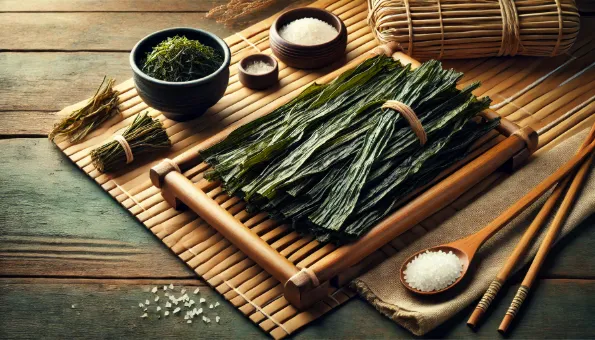Kombu (Seaweed): Mineral- & Umami-Rich Kelp for Stocks, Fermentation, Digestive-Friendly Fibers & Iodine
Dried brown kelp (mainly *Saccharina/Laminaria*) rich in glutamates, alginate fiber, iodine, trace minerals & phlorotannin antioxidants—used to build umami (dashi), tenderize legumes and enhance fermentation.

What Is Kombu?
Kombu is a **dried edible kelp** (commonly *Saccharina japonica*, formerly *Laminaria japonica*) used extensively in East Asian cuisines. Sold as thick, flat, dark green-brown blades with a natural white surface bloom of **mannitol crystals (mild sweetness)**. It provides clean oceanic umami, subtle sweetness and briny depth.
Nutrition (Approx per 5 g dry piece used for stock)
| | Amount | Notes |
|---|---|---|
| Calories | ~8–10 kcal | Very low energy |
| **Carbohydrate** | ~3 g | Mostly soluble fibers (alginates) + mannitol |
| **Fiber** | ~1–1.5 g | Viscous gel-forming |
| **Protein** | ~0.3 g | Contains glutamic acid |
| **Iodine** | 500–2,500 µg* | *Highly variable—portion control vital |
| Sodium (natural) | 30–60 mg | Varies with origin |
| Minerals | Ca, Mg, Fe, K trace | Sea mineral matrix |
Cooking in broth releases **free glutamates** for umami; much iodine diffuses into liquid.
Key Compounds
- **Glutamic acid & 5′-nucleotides**: Synergistic umami foundation of dashi.
- **Alginates & fucoidan**: Soluble fibers forming viscous gels (satiety, texture, potential prebiotic effects).
- **Mannitol**: Mild sweetness; FODMAP-sensitive individuals may need moderation.
- **Phlorotannins & carotenoids (fucoxanthin)**: Antioxidant pigments under study.
- **Iodine**: Essential for thyroid hormone synthesis; kombu is one of the richest natural sources.
Potential Culinary & Health Benefits
- **Umami intensifier** reduces need for added salt & animal stock; supports lighter, plant-forward dishes.
- **Mineral & iodine source** (in small amounts) contributing to thyroid function where intake is low.
- **Soluble fiber (alginates)** may aid satiety, modulate postprandial glycemia & improve mouthfeel in low-fat soups.
- **Legume tenderizer**: A strip of kombu in bean cooking water can shorten cooking time & enhance digestibility (softens cell walls).
- **Fermentation enhancer**: Adds nutrients & glutamates to kimchi, pickles or soy ferments aiding complexity.
Drawbacks & Precautions
- **Excess iodine risk**: Large or frequent portions (especially consuming rehydrated pieces) can exceed upper intake levels → potential thyroid dysfunction. Use modest, infusive quantities—discard or slice small pieces for consumption.
- **High sodium (natural + added salt in processed kelp)**: Rinse briefly if salt-cured.
- **Heavy metals**: Quality sourcing important; choose tested reputable brands.
- **FODMAP (mannitol)**: Large amounts may cause GI discomfort in sensitive individuals.
- Over-boiling (>30–40 min vigorous) can yield **iodine/seaweed harshness & sliminess**.
Culinary Uses
- **Dashi / Broth Base:** Soak kombu in cold water 20–40 min, then heat gently to just below simmer (remove before boiling) to extract clear umami.
- **Bean & Grain Cooking:** Add 1 strip (5–7 cm) to pot; remove after cooking for enhanced tenderness.
- **Pickling & Fermentation:** Thinly sliced kombu in quick pickles, kimchi, sauerkraut for umami and texture.
- **Seasonings:** Grind dried kombu to powder (with bonito flakes, shiitake, dried citrus) for natural MSG-like seasoning (furikake, umami salt).
- **Tsukudani:** Simmer rehydrated leftover strips in soy sauce, mirin, sesame for savory condiment.
- **Infused Oils / Vinegar:** Steep kombu pieces to create umami-rich finishing condiments.
Technique & Optimization
- **Avoid Boiling:** Remove or reduce heat before rolling boil to prevent bitterness & slimy polysaccharide over-extraction.
- **Score or Snip:** Lightly score surface or cut into squares to increase extraction area.
- **Cold Soak Start:** Encourages gentle diffusion of glutamates; then slow ramp to ~60–70 °C for optimal release.
- **Reuse:** A well-extracted sheet can be re-simmered again (secondary, lighter dashi) then minced for tsukudani—maximizing value & minimizing waste.
- **Balancing Umami:** Pair with shiitake (5′-GMP) or katsuobushi (5′-IMP) for synergistic effect.
Health & Portion Guidance
- Use **small piece (≈2–5 g dry)** per liter broth; most people should limit frequent large portions to avoid excessive iodine.
- Individuals with **thyroid disorders** (hyper/hypothyroid) or on iodine-restricted therapy should consult healthcare provider before regular kombu use.
- Rinse if sensitive to surface salts; soak water contains iodine—consider partial dilution if intake high.
- For FODMAP elimination, start with smaller infusions and discard the kelp before eating.
Sustainability Notes
Kelp aquaculture can **sequester carbon locally, absorb excess nutrients & provide habitat**. It requires **no freshwater, fertilizers or arable land**. Supporting farms practicing biodiversity-friendly cultivation & careful harvesting (avoiding wild over-foraging) maintains ecosystem services.
Storage
Keep dried kombu **airtight, cool & dark**; stable 1–2 years. Avoid humidity (causes mold or softening). After opening, reseal promptly; lightly toasting limp pieces can restore dryness. Rehydrated kombu: refrigerate (covered) up to 3 days or simmer into condiment.
Key Takeaways
✔︎ Powerful natural umami & soluble fiber with minimal calories
✔︎ Rich iodine—beneficial in moderation, risky in excess
✖︎ Overuse may lead to excessive iodine, bitterness or GI issues—portion mindfully.
- 1. Kombu (Seaweed)
Used in dashi and other broths

